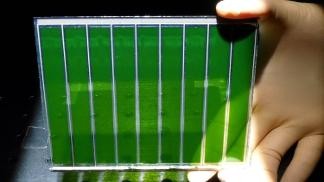A research team led by Michael Gratzel at the Laboratory of Photonics and Interfaces of EPFL has increased the Gratzel solar cell efficiency to 12.3%, which is now equivalent to that of existing silicon solar panels available in the market.
 Green dye-sensitized solar cells © 2011 EPFL
Green dye-sensitized solar cells © 2011 EPFL
The research team has also reduced the expenditures associated with the usage of this technology. It has reported its findings in an article published in the Science journal.
In order to augment the dye-sensitized solar cell efficiency to generate more amount of electricity, the research team used cobalt and porphyrin in place of standard dye materials, iodine and ruthenium. The utilization of these materials improves sunlight absorption, which allows more production of electricity by ensuring more effective transition of electrons to the substrate from the dye.
Gratzel cells imitate the photosynthesis process of plants. The new dye-sensitized cells mimic the process very closely and its new chemicals together provide them a green color. This color allows the process to efficiently convert light energy to electricity. In order to absorb optimum sunlight, the cell captures the spectrum colors having highest energies and releases the rest, including the green wavelengths.
Gratzel cells can be utilized to fabricate transparent and flexible solar panels. They can be used in certain applications where conventional rigid silicon solar panels fail to perform. Their theoretical optimal efficiency is now 30%, while that of silicon-based solar cells is 26%.